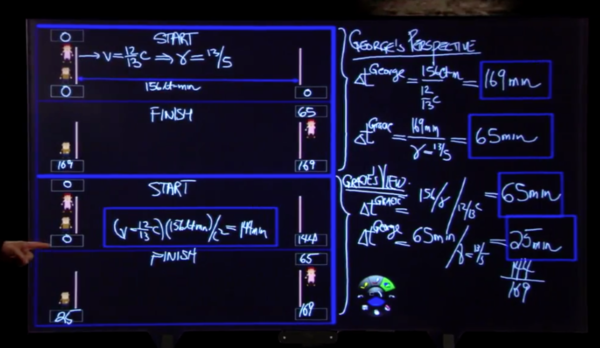 
 字體:小 中 大
字體:小 中 大 |
|
|
|
| 2014/07/15 15:31:36瀏覽2537|回應28|推薦33 | |
Gracie 以光速的 12/13 往右等速移動 156 光分(一光分等於 17,987,547 公里),George 留在原地。終點有一位裁判,他的碼表事先調校到和 George 的完全同步然後前去終點等候 Gracie。 George 計算出當裁判的碼表走到 169 分時 Gracie 應會抵達終點,「同時」他手上的碼表也會顯示 169 分整。他的以爲是對的。 George 也知道以 Gracie 運動的高速,她的時間會慢下來(叫 time dilation),屆時她自己的碼表將不會顯示 169 分鐘,而是 65 分鐘。Gracie 的感覺也不像 169 分鐘,而是 65 分鐘。George 的想法是對的。 之於 Gracie,她認為自己並沒有移動,是 George 往左平移遠去,右端的裁判自己平移來到她處,而整個跑道也自己以 12/13 光速高速往左移動。 由於高速左移的跑道會縮短(根據 Gracie 實際測量,叫 Lorentz contraction),Gracie 算出整條縮短的跑道在她眼前通過後,她的碼表將顯示 65 分,和 George 爲她預估的數值一模一樣。Gracie 也是對的。 由於 George 相對於 Gracie 也是以 12/13 的光速快速移動,所她也知道 George 的碼表將會前進到只 25 分鐘處,而非 169 分(time dilation 照常適用)。裁判的碼表才會顯示 169 分。同理開跑時裁判的碼表早已先行 144 分鐘,而非如 George 所說的歸零,George 的碼表才歸零。但這不是由於 George 說謊,而是由於兩人有相對高速運動,看法不一致。 爲什麼會這樣?因爲之於 George,裁判的碼表和他的碼表同時同步,但之於移動中的 Gracie,裁判的碼表一開始就已經「偷跑」,領先 George 144 分鐘,不同步。這個「領先」的值和 Gracie 的速度以及跑道的長度成正比。Gracie 的認知是對的。 所以 Gracie 到底花幾分鐘完成全程? Well 根據 Gracie 的碼表是 65 分鐘,根據 George 和裁判的碼表是 169 分鐘。George 人雖不在終點,但 George 會辯稱是 169 分鐘,因為裁判的碼表和他「同步」,雖然他人看不到但可以想見。但 Gracie 知道 George 和裁判都應該說 25 分鐘而非 169 分,Gracie 是對的。 Gracie 叫「裁判不公」!因爲他的碼表先行 144 分。裁判說可是我的碼表和 George 事前調校到同步啊?妳也在場不是?Gracie 說,之於你們可能同步,之於高速運動的我,你應該調到 George - 144 分才算同步。 也就是說如果裁判事先有這樣調校,他的碼表會顯示 169 - 144 = 25 分鐘而不是 169 分鐘。 或 George 如果事先有調校成裁判 + 144 分鐘的話,他的碼表就會顯示正確的 25 分鐘而不是 169 分鐘。 Gracie 還是對的。 也就是說,George 在碼表歸零時應該向裁判發出一道電訊說:「Now」!裁判應該在電訊抵達他時將碼表歸零,這樣兩個人才叫「同步」—— 之於 Gracie 同步,畢竟碼表是要用來測量 Gracie 的不是嗎? 之於 George,他根據自己測量的長度除以 Gracie 的速度所得後宣稱的 169 分是對的,他可以「藉由」裁判和他同步的碼表做此宣告。 之於 Gracie,她根據自己測量的長度除以跑道左移的速度所得後宣稱的 65 分也是對的,George 不會得到這個結論,但他可以「站在 Gracie 的立場」想,接受這個「Gracie 的事實」。 之於事前若有「正確調校」碼表的裁判,他宣稱的 25 分還是對的,George 碼表上的 25 分可以作證,一如前述 George 用裁判碼表的 169 分以為證那般。Gracie 不會得到這個結論,但她可以「站在裁判的立場」想,接受這個「裁判的事實」—— 或不事先正確調校裁判的碼表,就用開跑前 George 和裁判一起歸零的碼表,接受 George 169 分鐘這個「George 的事實」。 所以 Gracie 所花時間的真相是怎樣? George:169 分鐘 Gracie:65 分鐘 裁判:25 分鐘(假設碼表調校正確) 相對論把「同時」、「現在」的概念整個顛覆掉,任意兩點間沒有什麼叫做「同時」這回事,講「現在」也要在前面加一個主詞 —— 「誰」的現在? 而 Lorentz contraction 爲光子把宇宙縮成零距離,不論多遠它都一開始就已經「在那裏」;time dilation 把光子的「時鐘」無限延緩,不論多久它都是「零歲」,永不 age,所以說 「光子在瞬間遍訪宇宙」。由於光速的這種極限性與絕對性,宇宙才不可能有超光速的現象。光速之爲宇宙絕對極速事所必然,連比如說太陽現在忽然無端消失,地球也要八分二十秒後才會頓失光明,同時循一直線往銀河系某處飛去,因為光的「啟動」和「停止」都以光速傳遞,引力一樣,二者傳到地球都需要八分二十秒,但那只是我們的時間。之於光子或重力子,它們的看法是「地球在太陽消失的同時同分同秒頓失光明並停止繞日」,因為它們瞬間遍在任何處所,不需要時間;它們沒有「距離」的問題,也沒有「時間」這回事。 |
|
| ( 興趣嗜好|其他 ) |










